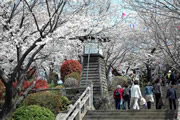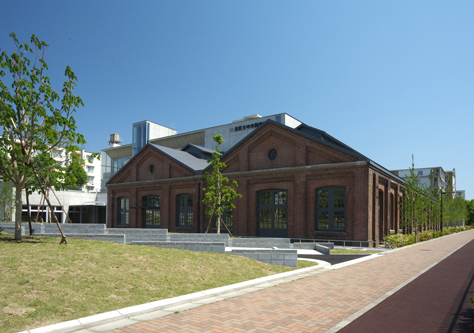ホーム > 区のプロフィール(区勢要覧) > 北区グラフィティー
ここから本文です。
掲載開始日:2015年2月21日
最終更新日:2015年2月21日
北区グラフィティー(名所紹介)
- 北区グラフィティー
- 北区風景
- 王子
- 赤羽
- 滝野川
飛鳥山公園 Asukayama Park
江戸時代から今もなお愛されるさくらの名所
 徳川八代将軍吉宗が、江戸庶民の行楽のためにさくらを植え開放しました。明治6年には、我が国最初の公園に指定されています。現在もさくらの名所として、多くの人が訪れます。公園内にある「飛鳥山3つの博物館」も見所です。渋沢史料館には、国の「重要文化財」に指定された大正期の2つの建物、「晩香廬(ばんこうろ)」と「青淵(せいえん)文庫」が庭園とともに当時のままの姿で残っています。
徳川八代将軍吉宗が、江戸庶民の行楽のためにさくらを植え開放しました。明治6年には、我が国最初の公園に指定されています。現在もさくらの名所として、多くの人が訪れます。公園内にある「飛鳥山3つの博物館」も見所です。渋沢史料館には、国の「重要文化財」に指定された大正期の2つの建物、「晩香廬(ばんこうろ)」と「青淵(せいえん)文庫」が庭園とともに当時のままの姿で残っています。Tokugawa Yoshimune (1684-1751), the eighth shogun,planted cherry trees on this site for the pleasure of thecitizens of Edo, opening it to the public. It wasdesignated as Japan's first park in 1873. Today thepark is still popular for its cherry blossoms andattracts many visitors. Inside the park there are the socalledthree museums of Asukayama. One of them,Shibusawa Memorial Museum, has two buildings, theBankoro and the Seienbunko, that are designated asImportant Cultural Properties by the state. Togetherwith the landscape garden, they are retained in theiroriginal form.
音無親水公園 Otonashishinsui Park
江戸風情ただよういこいの川辺
 かつて、この付近にあった王子七滝のひとつ「権現の滝」の再現や明治40年に架けられた舟串橋の復元など、数々の特色ある施設とさくら並木で彩られた公園は、「日本の都市公園百選」に選定されています。また、公園内に設置しているあんどん型照明は「手づくり郷土(ふるさと)賞」に選ばれて、夜の散歩にもおすすめです。
かつて、この付近にあった王子七滝のひとつ「権現の滝」の再現や明治40年に架けられた舟串橋の復元など、数々の特色ある施設とさくら並木で彩られた公園は、「日本の都市公園百選」に選定されています。また、公園内に設置しているあんどん型照明は「手づくり郷土(ふるさと)賞」に選ばれて、夜の散歩にもおすすめです。Otonashishinsui Park is considered one of Japan's top 100 cityparks for its reproduction of the Gongen-no-Taki waterfall, oneof the seven Oji waterfalls that were once located near the park,its rebuilt Funakushi Bridge originally constructed in 1907, andits cherry blossom trees. The andon-style lanterns throughoutthe park have received a handcraft award and make this anattractive place for strolling at night.
旧古河庭園 Kyu-Furukawa Gardens
バラに包まれた大正ロマンの洋館
 鹿鳴館の設計を手がけたイギリス人建築家、ジョサイア・コンドルによる英国ルネサンス風の洋館と洋風庭園、京都の庭師・植治の手がけた日本庭園とが美しい調和を生み出しています。平成18年1月に国の名勝に指定されています。春と秋には、いろいろな種類のバラが咲きほこり、遠方からも多くの人が訪れます。
鹿鳴館の設計を手がけたイギリス人建築家、ジョサイア・コンドルによる英国ルネサンス風の洋館と洋風庭園、京都の庭師・植治の手がけた日本庭園とが美しい調和を生み出しています。平成18年1月に国の名勝に指定されています。春と秋には、いろいろな種類のバラが咲きほこり、遠方からも多くの人が訪れます。There is a beautiful harmony between the British Renaissancestylebuilding and Western-style garden designed by JosiahConder, the British architect who also designed theRokumeikan in Hibiya, and the Japanese garden designed byUeji, the famous Kyoto landscape gardener. In January 2006 theKyu-Furukawa Gardens were designated as a national places ofscenic beauty. In spring and autumn various types of rosesblossom here, and many people visit from both near and far.
赤水門 Akasuimon
美しい姿で私たちを守り続けた
 旧岩淵水門はその門扉がまっ赤に塗られていることから「赤水門」という愛称で地元の人々に親しまれています。日本人でただ一人、パナマ運河の建設に携わった青山士あきらにより大正13年に建設されたものです。現在は役目を終え下流にある青い新岩淵水門が機能を果たしています。
旧岩淵水門はその門扉がまっ赤に塗られていることから「赤水門」という愛称で地元の人々に親しまれています。日本人でただ一人、パナマ運河の建設に携わった青山士あきらにより大正13年に建設されたものです。現在は役目を終え下流にある青い新岩淵水門が機能を果たしています。Because the former Iwabuchi floodgates are painted red, thelocal people affectionately refer to them as "Akasuimon" or "theRed Floodgates." These floodgates were built in 1924 by AkiraAoyama, the only Japanese national to be involved in theconstruction of the Panama Canal. Today, these floodgates areno longer in use and have been replaced by the new blueIwabuchi floodgates located downriver.
都電 Todenthe Arakawa Line
どこか懐かしい下町のチンチン電車
 都電荒川線は、王子電気軌道株式会社(王電)からはじまり昭和47年以降、都内唯一の路面電車となりました。北区内には6つの駅があります。都電が走るまちの風景は、どこかほっとする安らぎを感じさせてくれます。
都電荒川線は、王子電気軌道株式会社(王電)からはじまり昭和47年以降、都内唯一の路面電車となりました。北区内には6つの駅があります。都電が走るまちの風景は、どこかほっとする安らぎを感じさせてくれます。The Arakawa line streetcar (currently called the Toden Arakawa Line) wasoriginally operated by Oji Denki Kido (Oden). Since 1972, it has been the onlystreetcar line in Tokyo and it has six stops in Kita City. The sight of a streetcarrunning by somehow brings peace of mind to those who see it.
中央図書館 Central Library
レトロモダンな赤レンガの建築
 約30万冊の蔵書、約500席の閲覧席、インターネット利用席やゆったりとくつろげる喫茶室などを完備する北区の生涯学習の拠点となる滞在型図書館です。ユニバーサルデザインを取り入れ、車いすなどをご使用の方も利用しやすい高さの書架や机、トイレを採用しています。大正8年に建造された旧陸軍の赤レンガ倉庫を利用した建物は、重厚でありながらもモダンさを合わせ持ち、「赤レンガ図書館」とも呼ばれています。
約30万冊の蔵書、約500席の閲覧席、インターネット利用席やゆったりとくつろげる喫茶室などを完備する北区の生涯学習の拠点となる滞在型図書館です。ユニバーサルデザインを取り入れ、車いすなどをご使用の方も利用しやすい高さの書架や机、トイレを採用しています。大正8年に建造された旧陸軍の赤レンガ倉庫を利用した建物は、重厚でありながらもモダンさを合わせ持ち、「赤レンガ図書館」とも呼ばれています。This is a library with a collection of approximately 300,000 books, approximately 500 seats for reading, seats with Internet connections as well as a cafe where one can relax. This library is the center of lifelong learning activities in Kita where one can spend almost the entire day. The library features accessible, universal design allowing persons in wheelchairs easy access to the library with bookshelves, desks and restrooms that are easy to use for disabled persons. The building itself was built in 1919 and was a brick warehouse for the imperial army. It is a building that is both stately and modern and is also known as the “Red Brick Library.”

